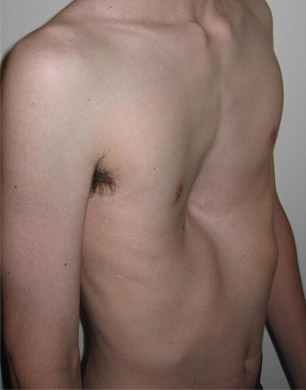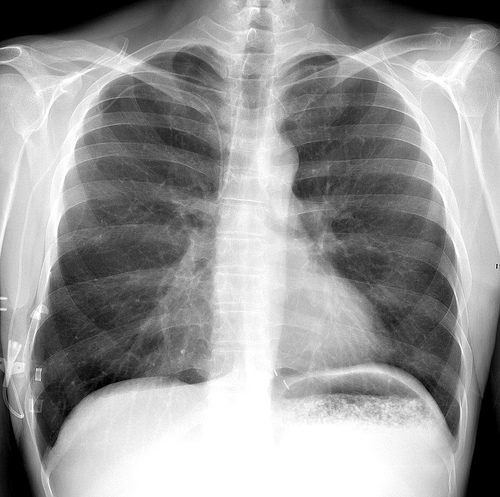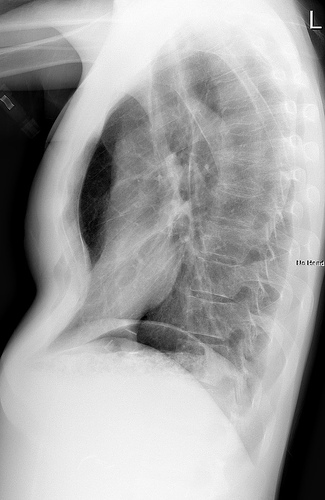Pectus excavatum
| Pectus Excavatum | |
 | |
|---|---|
| An example of a severe case. | |
| ICD-10 | Q67.6 |
| ICD-9 | 754.81 |
| DiseasesDB | 29401 |
| eMedicine | ped/2558 |
|
WikiDoc Resources for Pectus excavatum |
|
Articles |
|---|
|
Most recent articles on Pectus excavatum Most cited articles on Pectus excavatum |
|
Media |
|
Powerpoint slides on Pectus excavatum |
|
Evidence Based Medicine |
|
Clinical Trials |
|
Ongoing Trials on Pectus excavatum at Clinical Trials.gov Trial results on Pectus excavatum Clinical Trials on Pectus excavatum at Google
|
|
Guidelines / Policies / Govt |
|
US National Guidelines Clearinghouse on Pectus excavatum NICE Guidance on Pectus excavatum
|
|
Books |
|
News |
|
Commentary |
|
Definitions |
|
Patient Resources / Community |
|
Patient resources on Pectus excavatum Discussion groups on Pectus excavatum Patient Handouts on Pectus excavatum Directions to Hospitals Treating Pectus excavatum Risk calculators and risk factors for Pectus excavatum
|
|
Healthcare Provider Resources |
|
Causes & Risk Factors for Pectus excavatum |
|
Continuing Medical Education (CME) |
|
International |
|
|
|
Business |
|
Experimental / Informatics |
Editor-In-Chief: C. Michael Gibson, M.S., M.D. [1]
Associate Editor-In-Chief: Cafer Zorkun, M.D., Ph.D. [2]
Overview
Pectus excavatum is a congenital deformity (often present at birth) of the sternum, which is pressed into the chest, resulting in a "caved-in" or sunken appearance.
The deformity is sometimes considered to be a cosmetic rather than functional problem,however, recent studies have shown cases where pectus excavatum has impaired cardiac and respiratory function, and sometimes caused pain in the chest and back.[1]
Psychologically, untreated patients, especially youths, can experience negative psychosocial effects throughout their lives, avoiding activities where a shirt is not worn. Public awareness of Pectus Excavatum is limited, so youths suffering of the disorder may feel very alone. Media coverage has been scarce.
The condition usually progresses during the time of rapid bone growth in the early teenage years. Estimates for the prevalence of this condition range from one in 150 to 1000 children. Though the cause is not certain, the male/female ratio is 3 to 1, and occurrences of the condition in family members have been reported in 35% to 45% of cases.[2][3] These features may suggest a genetic component may be involved, although some authorities believe the condition occurs in a sporadic fashion.[4] Incidence is especially high among patients with inherited connective tissue disorders such as Marfan syndrome.
Pectus excavatum is sometimes referred to as "cobbler's chest", "funnel chest", "sunken chest", "chest bowl", or simply a "dent".
Diagnosis
Chest X-ray
Treatment
Surgery
Surgical correction has been shown to repair any functional symptoms that may occur in the condition, such as respiratory problems or heart murmurs, provided that permanent damage has not already arisen from an extremely severe case.[5]
Ravitch technique
The Ravitch technique is an invasive surgery that was developed in the 1950s to treat the condition. It involves cracking the ribs along the sternum, and reshaping the breastbone, cartilage, and ribs. It is usually kept in place with an apparatus worn around the chest. This method, because it is so invasive, is usually only recommended for adults or teenagers whose sternum has already hardened.
Nuss procedure
Since then, Dr. Donald Nuss, based at Children's Hospital of The King's Daughters (CHKD) in Norfolk, Virginia, has developed a technique that is minimally invasive. The Nuss procedure involves slipping in one or more concave steel bars into the chest, underneath the sternum. The bar is flipped to a convex position so as to push outward on the sternum, correcting the deformity. The bar usually stays in the body for about two years, although many surgeons are now moving toward leaving them in for up to five years. When the bones have solidified into place, the bar is removed through outpatient surgery.
The Vacuum Bell
A relatively new alternative to surgery is the vacuum bell. It consists of a bowl shaped device which fits over the caved-in area; the air is then removed by the use of a hand pump. The vacuum created by this lifts the sternum upwards, lessening the severity of the deformity. As it is such a recent device there is currently no information as to whether it is effective in the long term.
Cosmetic and light treatments
The cosmetic appearance of Pectus excavatum can reportedly be treated with a dermal filler called Bio-Alcamid. However, as this does nothing to alleviate the actual deformity it will not prevent any physiological symptoms caused by the condition.
Mild cases have also reportedly been treated with corset-like orthopedic support vests and exercise.[6]
See also
- Pectus carinatum - another anatomical variation of chest shape, characterized by a protrusion of the sternum.
References
- ↑ http://www.findarticles.com/p/articles/mi_m3225/is_n1_v46/ai_12450746
- ↑ http://www.emedicine.com/PED/topic2558.htm
- ↑ http://www.uihealthcare.com/topics/medicaldepartments/surgery/pectusexcavatum/index.html
- ↑ http://www.findarticles.com/p/articles/mi_m3225/is_n1_v46/ai_12450746
- ↑ http://www.findarticles.com/p/articles/mi_m3225/is_n1_v46/ai_12450746
- ↑ http://www.orthopectus.com.br/fmethod.htm
External links
- CHKD: Nuss Procedure for Pectus Excavatum
- UK Pectus Excavatum and Pectus Carinatum Information
- Pectus Excavatum Information and Message Board
- Pectuscast: A podcast about pectus excavatum and the Nuss procedure
- Felix Schier, Michael Bahr, Eckard Klobe: The vacuum chest wall lifter: an innovative, nonsurgical addition to the management of pectus excavatumnext term
- A better incision for pectus excavatum repair: avoiding the keloid triangle
de:Trichterbrust he:פקטוס אקסקבטום nl:Pectus excavatum fi:Kuopparinta sv:Trattbröst

